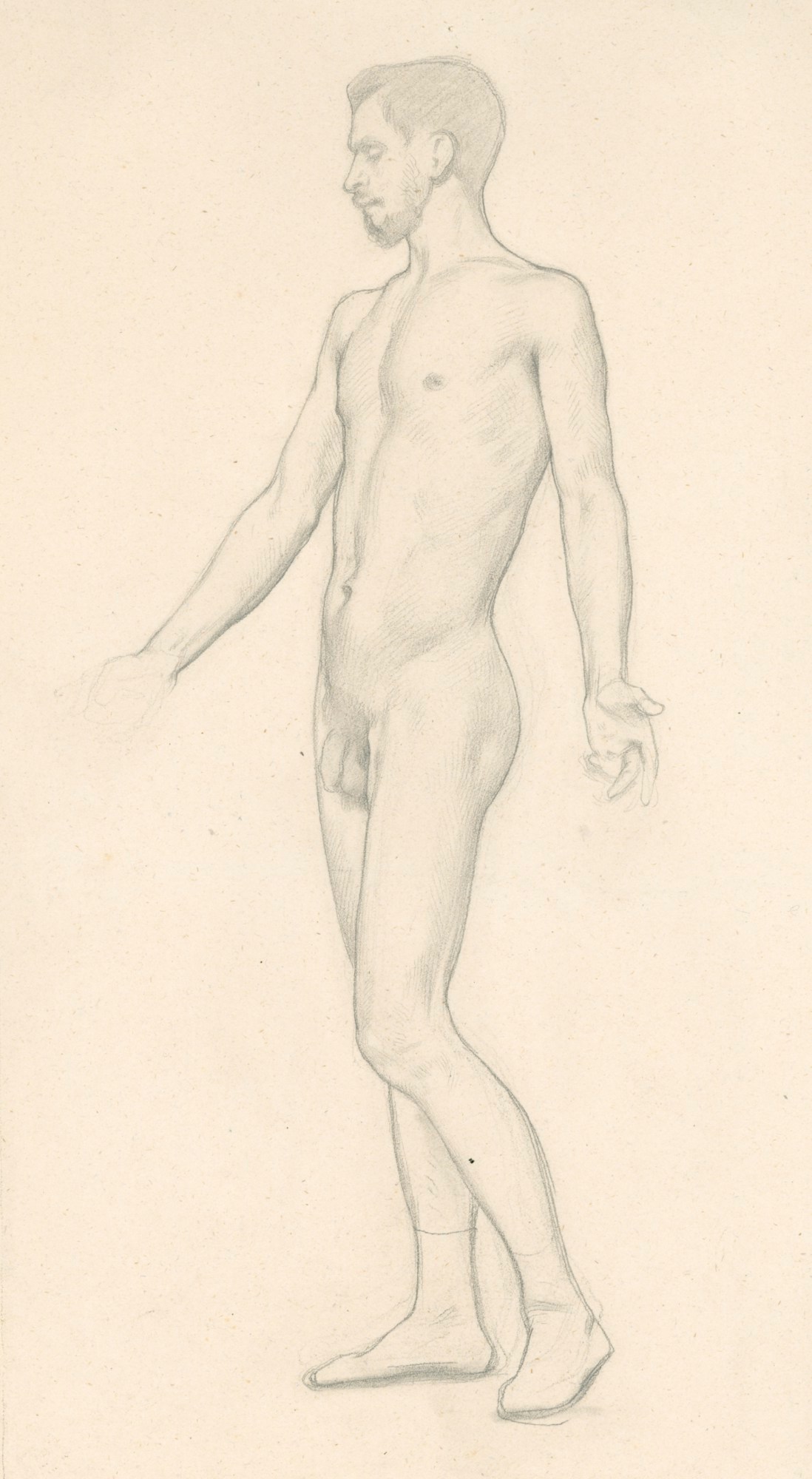
Lord Leighton PRA, Study of a standing male nude, 1850s?.
Pencil on cream wove paper. 287 mm x 157 mm. © Photo: Royal Academy of Arts, London.
This image is not available to download. To licence this image for commercial purposes, contact our Picture Library at picturelibrary@royalacademy.org.uk
Study of a standing male nude, 1850s?
Lord Leighton PRA (1830 - 1896)
RA Collection: Art
Planning his exhibition début in 1853, Frederic Leighton intended to paint two canvases - 'Cimabue's Celebrated Madonna' and 'The Reconciliation of the Montagues and the Capulets over the Dead Bodies of Romeo and Juliet' - one to be submitted to the Paris Salon and the other to the Royal Academy. Originally, the latter was to be the larger canvas and was destined for Paris where Leighton believed a large work would be more readily accepted. However, he eventually painted the Cimabue composition on a grander scale than 'The Reconciliation' and was persuaded to send it to the Royal Academy in 1855. It was exhibited and purchased by Queen Victoria for Prince Albert, for the sum of £600.
Leighton was habitually fastidious in his preparatory work but in the case of his first exhibition painting he was particularly meticulous. Many of these detailed studies of heads, figures and drapery are dated 1853 and were made in the winter and early spring of that year while Leighton was living in Rome. Hoping for some guidance, Leighton sent one of his studies to his Frankfurt mentor, the Nazarene painter Edward von Steinle, but the latter's response was a slightly negative warning against 'excessive fineness'. In a reply to Steinle's criticisms, Leighton explained his practice of making copious 'fine' studies by stating his belief that a young artist must master 'the foundation' of art before trying to emulate the 'broad', confident manner of the Old Masters; 'genuine mastership is not an acquired quality but an organised result...If we cast an eye over the progress of art-history, we see how the full, conscious, free, has developed itself out of the meagre, timourous, scrupulous, dry...You will easily understand how by the application of these maxims my preliminary works go forward rather timourously...I am laying the foundation on which I hope to rely firmly later on'. (see Mrs. Russell Barrington, The Life, Letters and Work of Frederic Baron Leighton of Stretton, London, 1906, Vol I, p. 155-56)
This group of life drawings are very similar in style and arrangement. One is inscribed 'Rome 1853' and it is very likely that the others were also made at life classes either in Rome or in Frankfurt where Leighton studied at the Städelsches Institut. Having completed his training with the Nazarene painter Edvard von Steinle in Frankfurt, Leighton arrived in Rome on the 19th November 1852 remaining there, apart from visits to his family in Germany, until 1855 when he moved to Paris.
Many of these life studies are drawn in pencil with a sharp outline and light modelling effected by the close-knit hatching of fine lines. The academic quality of the drawings derives from Leighton's rigorous training. In later years, Leighton retained a methodical approach to the preparation of his compositions but his life drawings became considerably less restrained and he favoured the more fluid medium of black and white chalks on brown paper.
Object details
287 mm x 157 mm
Start exploring the RA Collection
- Explore art works, paint-smeared palettes, scribbled letters and more...
- Artists and architects have run the RA for 250 years.
Our Collection is a record of them.



